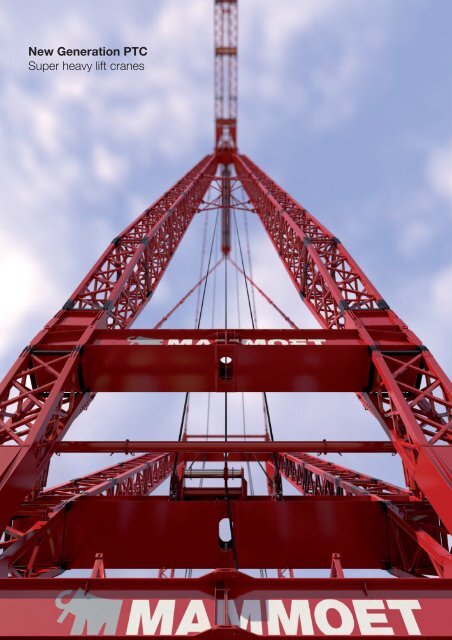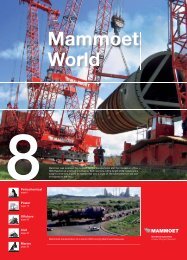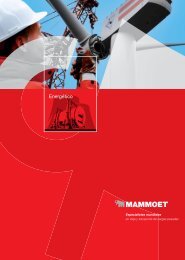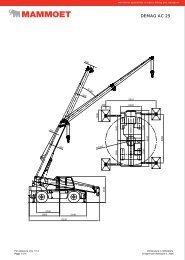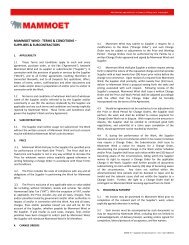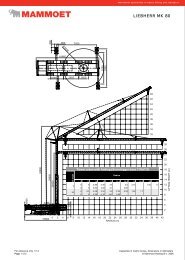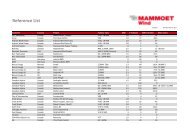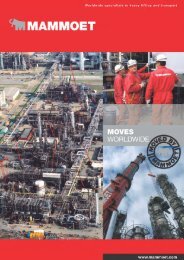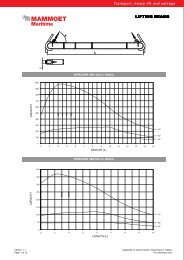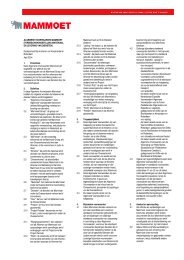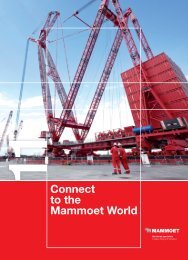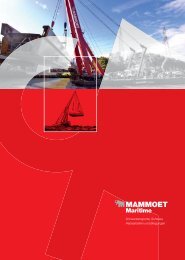New Generation PTC Super heavy lift cranes - Mammoet BV
New Generation PTC Super heavy lift cranes - Mammoet BV
New Generation PTC Super heavy lift cranes - Mammoet BV
Create successful ePaper yourself
Turn your PDF publications into a flip-book with our unique Google optimized e-Paper software.
<strong>New</strong> <strong>Generation</strong> <strong>PTC</strong><br />
<strong>Super</strong> <strong>heavy</strong> <strong>lift</strong> <strong>cranes</strong>
7<br />
The “smallest” super <strong>heavy</strong> <strong>lift</strong> <strong>cranes</strong><br />
<strong>Mammoet</strong>’s <strong>New</strong> <strong>Generation</strong> <strong>PTC</strong> <strong>cranes</strong> - key features<br />
1. Designed and built to the highest international safety standards, verifi ed by Lloyd’s Register 12<br />
2. Nonstop load chart interpolation: fl exibility and time savings 13<br />
3. Luffi ng jib reaches across plant structures, without reduction of the load moment 14<br />
4. Wheeled bogies: slew a full circle in 15 minutes 14<br />
5. Fast winches <strong>lift</strong> loads up to 3,200 t (3527 US ton) to 120 m (394 ft) from 12 minutes 15<br />
6. Winches, not strand jacks, so no need for frequent hoist rope replacement 15<br />
7. Smallest footprint <strong>heavy</strong> <strong>lift</strong> crane: swing radius, including ballast, only 22 m (72 ft) 16<br />
8. Low ground bearing pressure: max. 20 t/m² (4100 psf) across a diameter of 45 m (148 ft) 16<br />
9. High reliability: electric and hydraulic systems 100% redundant and the experience of 17<br />
17,000 <strong>PTC</strong> <strong>lift</strong>s<br />
10. Operational wind speed 14 m/s (31 MPH), design wind speed 18.5 m/s (41 MPH), 18<br />
survival mode 67 m/s (150 MPH)<br />
11. For all climates: artic-proof down to -40°C (-40°F), desert-proof up to +55°C (+131°F) 19<br />
- no load chart reduction<br />
12. Containerized: worldwide mobilization in 3 to 6 weeks 19<br />
13. Relocation on site on SPMTs or on crane track 19<br />
14. Reduced environmental impact: “green ballast” and reduced emissions 20<br />
<strong>Mammoet</strong>’s <strong>New</strong> <strong>Generation</strong> <strong>PTC</strong> <strong>cranes</strong>:<br />
Versatile and effi cient super <strong>heavy</strong> <strong>lift</strong> <strong>cranes</strong> with a small footprint<br />
page
8<br />
<strong>PTC</strong>: Platform Twinring, Containerized<br />
<strong>Mammoet</strong> has a worldwide fl eet of some 1300 <strong>cranes</strong>. However, conventional <strong>cranes</strong> are simply not<br />
enough for our largest projects. In 1996 we designed and built our fi rst <strong>PTC</strong>. The crane platform rests on<br />
a ring for slewing, the twin booms form a stable A-frame, and all the components are the size of standard<br />
shipping containers. These <strong>PTC</strong>s allowed us to undertake large projects more effi ciently, even at remote<br />
sites. <strong>Mammoet</strong> now has more than ten of these <strong>cranes</strong> and a wealth of experience developed over<br />
17,000 <strong>heavy</strong> <strong>lift</strong>s with them. We also have 15 years’ of in-house expertise of engineering these super<br />
<strong>heavy</strong> <strong>lift</strong> <strong>cranes</strong>.<br />
The success on the market proved the validity of the concept and we have developed it into the <strong>New</strong><br />
<strong>Generation</strong> <strong>PTC</strong> <strong>cranes</strong> described in-depth in this brochure. We are building three of these <strong>cranes</strong>, in two<br />
sizes, and already have several launch customers designing projects around them.
9<br />
15 years of in-house engineering<br />
MSG T30 PT50 <strong>PTC</strong>35 <strong>PTC</strong>35 DS <strong>New</strong> <strong>Generation</strong> <strong>PTC</strong><br />
1996 2000 2011<br />
Gantry: Strandjacks Sliding Bogies Winches Wheel Bogies
10<br />
Cranes and sliding gantries compared<br />
The <strong>PTC</strong>s are real <strong>cranes</strong>, not sliding gantries (or <strong>lift</strong>ing machines). Sliding gantries operate more slowly,<br />
move on skid shoes, and use strand jacks for <strong>lift</strong>ing. This is a suitable concept for a single <strong>heavy</strong> <strong>lift</strong> during<br />
a project, for example using <strong>Mammoet</strong>’s MSG system. However, a <strong>PTC</strong> crane is far more versatile and<br />
effi cient and can be used for many <strong>lift</strong>s during a project. Furthermore, the strand wire used with strand jack<br />
systems suffer <strong>heavy</strong> wear and need to be replaced after a few <strong>lift</strong>s, which is costly and takes time.<br />
MSG (single <strong>lift</strong>)<br />
Single <strong>lift</strong> versus multi <strong>lift</strong>s<br />
<strong>PTC</strong> (multi <strong>lift</strong>s)
11<br />
<strong>Mammoet</strong> <strong>PTC</strong> (multi <strong>lift</strong>s)<br />
MSG (single <strong>lift</strong>)
12<br />
1. Designed and built to the highest international safety<br />
standards<br />
The <strong>New</strong> <strong>Generation</strong> <strong>PTC</strong>s are designed to meet both European and American safety standards<br />
(EN 13000, ISO 4305, ASME B30.5, SAE J987, ASME NQA-1). The design and construction are fully<br />
certifi ed by Lloyd’s Register (design approval, fabrication survey, test witnessing). This included a full and<br />
detailed design review.<br />
One of the key design requirements was to ensure the safety of the riggers when erecting the crane. This<br />
has been done by providing safe walkways and other fall-protection measures. Hence, the high safety<br />
standards you maintain will be complied with throughout <strong>Mammoet</strong>’s presence on your plant.<br />
These <strong>PTC</strong>s feature unique hydraulic pin connections designed in-house by <strong>Mammoet</strong>. These improve<br />
safety and save time when erecting the crane. Furthermore, this design reduces the wear of the pins,<br />
again enhancing safety and reliability.
13<br />
2. Nonstop interpolation<br />
There are three options for rigging the <strong>New</strong> <strong>Generation</strong> <strong>cranes</strong> :<br />
- main boom (SSL)<br />
- main boom + fi xed jib (SFSL)<br />
- fi xed main boom + luffi ng jib (SWSL)<br />
These modes make the <strong>cranes</strong> even more versatile when striking the balance between maximum load and<br />
maximum radius, and give a greater choice when determining their location on site.<br />
For operation in SWSL mode, load charts are provided for selected main boom angles. For greater<br />
fl exibility, interpolation between two load charts possible. This is <strong>Mammoet</strong>’s unique “nonstop interpolation”<br />
principle on a ringer crane. This means that any <strong>lift</strong> can be planned to make the best use of the crane<br />
capacity.<br />
The load charts for the SSL and SFSL modes specify the maximum loads at specifi c radii. The maximum<br />
load at an intermediate radius may be obtained by interpolation within a load chart.<br />
235m<br />
(770 ft)<br />
Non-stop interpolation<br />
205m (672 ft)<br />
Variable Angle
14<br />
3. Luffi ng jib to reach across plant structures<br />
The <strong>New</strong> <strong>Generation</strong> <strong>PTC</strong>s are generally fi tted with a luffi ng jib [length: 42 m (138 ft) – 106 m (348 ft)] to <strong>lift</strong><br />
loads across structures on your plant. The luffi ng jib also makes it possible to position the crane such that<br />
a more favorable load moment is obtained. This is a great advantage over sliding gantries with a rigid main<br />
boom, which have to be positioned at a much greater distance from the load to reach over structures. The<br />
smaller operating area required by a <strong>PTC</strong> is another key advantage, especially on congested sites.<br />
For a <strong>PTC</strong> with luffi ng jib, a load of 1000 t (1100 US ton) at a radius<br />
of 100 m (328 ft) is a easy feasable <strong>lift</strong>.<br />
The control software incorporates “virtual walls”, essentially<br />
exclusion zones to ensure that the crane only operates in a<br />
permitted area, to ensure safe operations.<br />
4. Wheeled bogies for effi cient slewing<br />
GBP = 20 t/m 2 (4100 psf)<br />
The <strong>New</strong> <strong>Generation</strong> <strong>PTC</strong>s slew on bogies and can rotate a full circle in just 15 minutes. This makes<br />
operations much more effi cient than with sliding gantries moving on skid shoes.<br />
Slewing 360 degrees means that loads can be picked up and placed across a large part of the site,<br />
for more effi cient <strong>lift</strong>ing operations. The control system suppresses stick-slip at the start of slewing, for<br />
smoother operation and greater safety. The slewing drive is powered by redundant hydraulic powerpacks<br />
for high reliability.
15<br />
360°<br />
15 minutes<br />
125 - 250 t<br />
up to<br />
20 m/min<br />
138 - 276 US<br />
ton up to<br />
66 ft/min<br />
250 - 3200 t<br />
120 m from<br />
12 minutes<br />
276 - 3527<br />
US ton<br />
394 ft from<br />
12 minutes<br />
5. Fast winches<br />
The <strong>cranes</strong> are fi tted with four<br />
800 t (882 US ton) main winch<br />
systems for a total <strong>lift</strong>ing capacity<br />
of 3,200 t (3527 US ton). These<br />
winches are automatically<br />
synchronized and controlled.<br />
Loads up to the maximum<br />
capacity are hoisted at a speed of<br />
10 meters per minute (33 ft/min).<br />
This makes operations much<br />
more effi cient than with gantries<br />
using strand jacks which typically<br />
have a <strong>lift</strong>ing speed of 10 meters<br />
per hour (33 ft/hr).<br />
The <strong>New</strong> <strong>Generation</strong> <strong>PTC</strong>s are<br />
also fi tted with a 250 t (276 US<br />
ton) auxiliary hoist, with a <strong>lift</strong>ing<br />
speed of 10 (33 ft/min) or<br />
20 m/min (66 ft/min), depending<br />
on the confi guration.<br />
All <strong>lift</strong>ing operations are monitored<br />
by fully redundant load cells in the<br />
main boom and luffi ng jib, and<br />
controlled by duplicated PLCs.<br />
The electronic systems also<br />
feature remote diagnostics for<br />
improved effi ciency and safety.<br />
6. Winches, not<br />
strand jacks<br />
Although strand jacks are<br />
valuable tools for <strong>heavy</strong> <strong>lift</strong>ing<br />
operations, and regularly used by<br />
<strong>Mammoet</strong>, they are best suited to<br />
single <strong>lift</strong> projects. This is because<br />
they are slow and wear the strand<br />
wire out quickly which then<br />
needs replacement. The <strong>New</strong><br />
<strong>Generation</strong> <strong>PTC</strong>s use winches for<br />
more effi cient operations and a<br />
much longer rope life.
16<br />
7. Small footprint<br />
As the <strong>New</strong> <strong>Generation</strong> <strong>PTC</strong>s carry all the ballast within the ring they have zero tail swing. This is a great<br />
advantage when operating on congested sites. It also means the crane can be positioned closer to the<br />
load to make better use of the available load moment.<br />
The swing radius of only 22 meters (72 ft) (including ballast) makes the <strong>New</strong> <strong>Generation</strong> <strong>PTC</strong> <strong>cranes</strong> the<br />
“smallest” super <strong>heavy</strong> <strong>lift</strong> <strong>cranes</strong>.<br />
<strong>PTC</strong> Footprint diameter 45 m (148 ft) <strong>PTC</strong> Footprint diameter 55 m (180 ft)<br />
140,000 tm<br />
GBP = 20 t/m 2 (4100 psf)<br />
8. Low ground bearing pressure<br />
200,000 tm<br />
GBP = 20 t/m 2 (4100 psf)<br />
The <strong>New</strong> <strong>Generation</strong> <strong>PTC</strong> <strong>cranes</strong> have load spreaders, with an outside diameter of 45 m (148 ft).<br />
This results in a maximum ground bearing pressure (GBP) of 20 t/m². Hence, only limited site preparations<br />
will be needed. This is a key advantage over equipment such as <strong>heavy</strong> crawler <strong>cranes</strong> which can have a<br />
GBP up to 100 t/m² (20500 psf).
17<br />
9. High reliability: 100% redundant systems<br />
All key electric and hydraulic components of the <strong>New</strong> <strong>Generation</strong> <strong>PTC</strong>s, such as the power packs,<br />
gearboxes, slewing and hoisting drives, PLCs and electronics are fully duplicated. Hence, repairs and<br />
maintenance can be carried out without interrupting the <strong>lift</strong>ing operations.<br />
The hydraulic powerpack is driven by two Caterpillar C18 diesel engines which meet strict emission<br />
requirements. If one powerpack fails or needs to be shut down for maintenance, the crane can continue<br />
operations at full capacity. In the unlikely event of failure of both powerpacks the crane can be operated<br />
using an external powerpack (manual system).<br />
The PLCs, load cells on the boom and jib and SLI/LMB safety systems and their cabling are also fully<br />
duplicated. In the event of a serious external factor the crane is switched from the master to the back-up<br />
systems and will be operational again within fi ve minutes. Should all control systems fail then the crane<br />
may be operated manually to lower the load.<br />
Each of the main winches is fi tted with six hydromotors but can operate at full capacity with only four.<br />
Again this means that <strong>lift</strong>ing operations are not delayed by maintenance or repairs.<br />
Redundancy for Drive: + 200% Redundancy, 100% Redundancy and Manual system<br />
Redundancy for Boom-Electric (Loadcell, LMB): + 200% Redundancy, 100% Redundancy
18<br />
The design of the <strong>New</strong> <strong>Generation</strong> <strong>PTC</strong>s benefi ts from 15 years’ experience and 17,000 <strong>lift</strong>s with our<br />
previous ring <strong>cranes</strong>, often in demanding environments. The <strong>Mammoet</strong> engineering department has<br />
analyzed the data gathered during these operations and used it to optimize the <strong>PTC</strong> design in terms of<br />
safety, reliability and effi ciency.<br />
Redundancy 200% Redundancy 100%<br />
F.e. Hit by lightning<br />
- Mastersystem 100%<br />
- backup system 100%<br />
- manual 0%<br />
- Mastersystem 0%<br />
- backup system 100%<br />
- manual 0%<br />
Optimal Operation Operational again:<br />
within 5 minutes<br />
10. Resist high wind speeds<br />
Manual Redundancy<br />
F.e. Hit by earthquake<br />
- Mastersystem 0%<br />
- backup system 0%<br />
- manual 100%<br />
➔ ➔ ➔<br />
Secure load:<br />
within 4 hours<br />
Hurricane Survival Mode<br />
F.e. Hit by hurricane<br />
- Mastersystem 0%<br />
- backup system 0%<br />
- manual 100%<br />
Hurrican survival mode:<br />
within 4 hours<br />
The strong A-frame formed by the twin boom allows operations at wind speeds up to 14 m/s (31 MPH),<br />
but until 50 m/s (112 MPH) the mainboom and luffi ng jib can remain fully erected. The crane can be made<br />
Hurricane proof [max. 67 m/s (150 MPH)] within four hours. No auxiliary crane is needed for this, or for<br />
return to normal operations.<br />
11. Operate and survive in demanding environments<br />
67 m/s<br />
(150 MPH)<br />
<strong>Mammoet</strong> has extensive experience operating in extremely hot and cold environments. The <strong>New</strong><br />
<strong>Generation</strong> <strong>PTC</strong>s can operate in arctic environments down to -40°C (-40°F) or in deserts up to +55°C<br />
(+131°F) without any impact on the load charts. Many other <strong>cranes</strong> in the market have to be derated<br />
below -20°C (-4°F) because of the brittleness of steel components at low temperatures. The <strong>New</strong><br />
<strong>Generation</strong> <strong>PTC</strong>s is built to even survive moderate earthquakes (exact rating t.b.d.).
19<br />
12. Rapid mobilization, worldwide<br />
Like all <strong>PTC</strong>s, the <strong>New</strong> <strong>Generation</strong> <strong>cranes</strong> break down into components the size of a standard 20 or<br />
40 foot shipping container. Consequently they can be shipped worldwide without the need for special<br />
equipment at ports or in transit. This is a major advantage when working on remote sites in areas with<br />
a poor infrastructure. The luffi ng jib means that a <strong>PTC</strong> is partly self erecting and needs a relatively small<br />
assembly area. Only two mobile <strong>cranes</strong> are needed, which can be provided by <strong>Mammoet</strong> or obtained<br />
locally. Assembling generally takes three to six weeks.<br />
13. Relocation on-site<br />
on crane tracks using SPMTs<br />
The luffi ng jib and large radius of the <strong>New</strong> <strong>Generation</strong> <strong>PTC</strong>s mean that there will be little need to move<br />
them on site. However, they can be relocated without disassembly using SPMTs (Self-Propelled Modular<br />
Transporters) or on crane tracks.
20<br />
14. Reduced environmental impact<br />
Like all large <strong>cranes</strong>, the <strong>New</strong> <strong>Generation</strong> <strong>PTC</strong>s need a signifi cant amount of ballast. Instead of<br />
transporting the ballast from a <strong>Mammoet</strong> depot, locally sourced material is used to reduce the<br />
environmental impact associated with transport. This is <strong>Mammoet</strong>’s “green ballast” concept. The<br />
Caterpillar powerpacks are fuel-effi cient and meet strict emission requirements. The power management<br />
system can shut one of the duplicated powerpacks down to reduce emissions and fuel consumption.<br />
Market segments<br />
Offshore<br />
Module <strong>lift</strong>ing in short time: FPSO, FLNG (PAR, PAU)<br />
f.e. Module <strong>lift</strong>ing moving on rail track
21<br />
Power<br />
Power: all <strong>lift</strong>s effi cient in short time from 1 position<br />
f.e. 1000t @ 100m radius (1100 US ton @ 328 ft)
22<br />
Petrochemical<br />
Safe and less downtime<br />
f.e. 2500t @ 65m radius (2756 US ton @ 213 ft)<br />
f.e. 3200t @ 55m radius (3527 US ton @ 180 ft)
23<br />
load [t]<br />
load [US ton]<br />
3500<br />
3000<br />
2500<br />
2000<br />
1500<br />
1000<br />
500<br />
0<br />
4000<br />
3500<br />
3000<br />
2500<br />
2000<br />
1500<br />
1000<br />
500<br />
0<br />
combined load charts [metric units]<br />
0 25 50 75 100 125 150 175 200 225<br />
radius [m]<br />
combined load charts [US customary units]<br />
140,000 tm<br />
200,000 tm<br />
0 100 200 300 400 500 600 700<br />
radius [ft]<br />
140,000 tm<br />
200,000 tm
25<br />
<strong>Mammoet</strong>: “Worldwide leader in engineered <strong>heavy</strong> <strong>lift</strong>ing,<br />
transport and project logistics”<br />
<strong>Mammoet</strong> is the world‘s leading provider of turnkey engineered <strong>heavy</strong> <strong>lift</strong>ing and transport solutions.<br />
Our core business is the transport, shipping, installation (including horizontal and vertical positioning)<br />
and removal of <strong>heavy</strong> or large objects, to and from any location, onshore and offshore. Our engineering<br />
skills, experience, thousands of highly skilled professionals and a vast fl eet of state-of-the-art equipment,<br />
combined with high quality and safety standards, have made <strong>Mammoet</strong> a market leader, setting trends<br />
and records around the world.<br />
Markets Fleet<br />
Petrochemical<br />
Power<br />
Offshore<br />
Civil<br />
Marine<br />
• 1,300 <strong>cranes</strong> and sliding gantries,<br />
10 – 3,600 t<br />
• Jacks, skids and gantries, up to<br />
100,000 t<br />
• 3,100 axle lines of Self-Propelled<br />
Modular Transporters (SPMTs) and<br />
conventional trailers<br />
• Sheerlegs, barges and other<br />
maritime equipment<br />
Company<br />
• Annual revenues approx.<br />
EUR 1 billion<br />
• 3,600 employees<br />
• In-house engineering department<br />
Parent company: SHV<br />
• Annual revenues approx.<br />
EUR 12 billion<br />
• 45,000 employees<br />
Safety always a top priority<br />
Safety comes fi rst in everything we do. <strong>Mammoet</strong> operates a stringent, successful and highly respected<br />
Safety, Health, Environment and Quality Program (SHE-Q). These standards are always upheld for the<br />
safety of all the people and objects involved. The program is implemented throughout our organization,<br />
backed up by training and development programs. Our safety offi cers focus on safety and the impact of<br />
our activities on the environment, but it is not their responsibility alone: it is a key responsibility of everyone<br />
working at <strong>Mammoet</strong>.<br />
Inventive and innovative<br />
Invention and innovation are in our blood, as every assignment is unique. Our in-house engineering<br />
department develops specialist solutions and equipment for complex projects. The <strong>New</strong> <strong>Generation</strong> <strong>PTC</strong><br />
<strong>cranes</strong> covered in this brochure are one example of their work.<br />
Worldwide presence<br />
<strong>Mammoet</strong> has 90 offi ces and operational bases throughout the world to keep lines of communications<br />
short. Our advanced logistics operations can deploy equipment quickly, even at remote sites.
26<br />
www.mammoet.com/ptc<br />
watch updated news <strong>Mammoet</strong>’s <strong>New</strong> <strong>Generation</strong> <strong>PTC</strong> Cranes
27<br />
<strong>Mammoet</strong>’s <strong>New</strong> <strong>Generation</strong> <strong>PTC</strong> <strong>cranes</strong><br />
The “smallest” super <strong>heavy</strong> <strong>lift</strong> <strong>cranes</strong><br />
Main offi ce:<br />
<strong>Mammoet</strong> Holding B.V.<br />
Karel Doormanweg 47, Haven 580<br />
3115 JD Schiedam<br />
The Netherlands<br />
Tel: +31 (0) 10 2042 424<br />
Fax: +31 (0) 10 2042 442<br />
info@mammoet.com<br />
www.mammoet.com<br />
24/7


